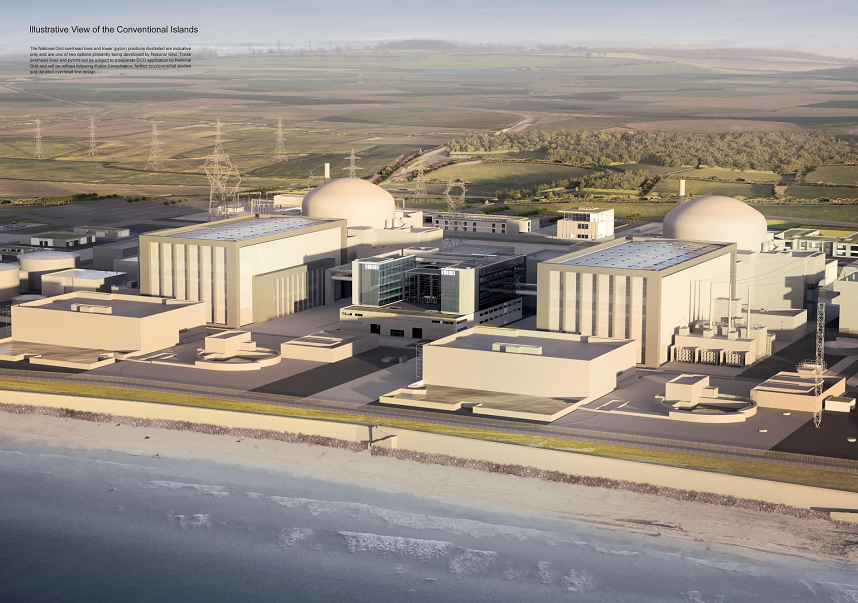
The new multibillion-pound Hinkley Point C nuclear power station has reached its biggest milestone with completion of the base for the first reactor.
Construction of the nuclear buildings above ground at the site in Somerset can now begin in earnest, said operators EDF Energy.
The final amount of concrete was the largest ever recorded in the UK, beating a record set by the Shard in London, said EDF.
The base, reinforced with 5,000 tonnes of Welsh steel, has been under construction by the UK-French joint venture of Bouygues-Laing O’Rourke for six months.
EDF gave an update on the project, saying almost 4,000 people are now working at the site, half of them from the local area.
Forgings for the pressure vessel and steam generators are under way at Framatome in France and the world’s largest turbine is under construction at GE.
The world’s largest crane is taking shape on site to allow prefabrication of large parts of the nuclear buildings.
EDF said £1.5 billion of contracts have been awarded in the South West and almost two thirds of the project value is being spent with UK firms, while 430 out of 1,000 apprentices have been hired.
Minister for nuclear Andrew Stephenson said: “This is a huge achievement for Hinkley Point C and a major milestone for the UK’s nuclear new-build industry, which, as a low-carbon electricity source, is key to meeting our ambitious target of net-zero emissions by 2050.
“The project will not only power nearly six million homes, it will add an enormous boost to the local and national economy, delivering over 25,000 new jobs and securing long-term, well-paid employment, a key step in delivering clean growth as part of our modern industrial strategy.”
Hinkley Point C managing director Stuart Crooks said: “I am proud of the talent and achievement of our diverse UK workforce, our unions, our international supply chain and the design team in France.”
EDF Energy chief executive Simone Rossi said: “Hinkley Point C’s progress is good news for anyone concerned about the climate change crisis.
“Its reliable low-carbon power will be essential for a future with no unabated coal and gas and a large expansion of renewable power.
“The innovation at Hinkley Point C sets up the opportunity to reduce costs for consumers for a near-identical power station at Sizewell C in Suffolk.”
Full construction at Hinkley Point C got under way after EDF, its Chinese partner CGN and the Government signed final contracts in 2016.
The power station will supply the UK with electricity to meet 7% of the country’s needs from the mid-2020s.
Sue Ferns, of the Prospect union, said: “Hitting milestones on time like this is a key indicator of the viability of new nuclear.
“Learning lessons and transferring skills from this to other new nuclear projects will enable the UK to keep costs down.”
Meanwhile, the CBI has written to the Government saying that the UK should build new nuclear power stations and scale up carbon capture technology and infrastructure to reach its target of net-zero greenhouse gas emissions by 2050.
The business group set out a series of priorities to decarbonise the UK economy and called on the Government to use a forthcoming energy white paper to give more clarity on its vision.
Unite national officer Peter McIntosh said: “This is a major milestone for Hinkley Point and clearly demonstrates that the UK’s workforce can deliver on major infrastructure projects.
“This excellent news should act as a spur for ministers to ensure that Sizewell C and Bradwell B in Suffolk are well-supported and that the lessons learnt by the construction at Hinkley Point C are passed on to enable the Sizewell projects to deliver real savings.
“They should also look at resurrecting the nuclear projects at Moorside in Cumbria which Toshiba withdrew from last November and Wylfa in Anglesey, where Hitachi suspended construction work earlier this year.”
Justin Bowden, GMB national officer, said: “If the UK is serious about becoming a carbon-free economy then, starting with Sizewell C in Suffolk, we need at least another six new nuclear power stations for their reliable electricity as part of a balanced energy mix alongside green hydrogen gas and intermittent sources like wind and solar.”
Recommended for you
